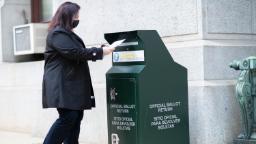
What Matters: Your E-10 election speed read

Current party spread in early votes: 49% D, 28% R, 16% No Party, 7% other.
That comes all comes from Catalist, an analytics firm that provides data to Democrats, academics and nonprofit groups. (Note: About 42% of voters cast their ballots early or by mail in 2016. We’re on pace to far eclipse that margin.)
Joe Biden won the debate. That’s according to CNN’s post-debate poll, although it was by a much narrower margin than the first debate.
Donald Trump’s supporters were happy anyway — The President raised $26 million, his largest one-day digital fundraising haul, according to the Trump campaign.
With Trump muted for portions of the debate, the candidates were able to get into the nuts and bolts of an actual policy discussion. I spent the wee hours of last night trying to simply lay out the differing visions they laid out. Read the entire thing here.
On Covid:
Trump continued to downplay the severity of the virus and defend his early reaction — restricting travel from China — and promising, despite the facts, that a vaccine will be ready shortly.
Biden, pointing to the death toll from the virus, repeatedly held up a mask and said he’d push common-sense advice to states to encourage mask-wearing, social-distancing and restrictions on things like dining in restaurants if there are outbreaks in a state.
As if the virus never happened, Trump continues to argue he should be judged for the pre-Covid economy and the pre-Covid reality. He said millions could have died from Covid, as if that absolves him from having to deal with the fact that hundreds of thousands have died on his watch.
Read the latest about the fall Covid surge and where it’s exploding.
Existential threat or punchline?
It was on climate change and energy policy that they were furthest and most consequentially apart.
Trump’s main policy attack line on Biden is that he would end fracking (Biden says he’d transition away from the oil-based economy, but not immediately end anything), and mocks the switch to renewable energy that’s the backbone of Biden’s economic plan.
Bill Weir covers the climate crisis for CNN and wrote this, which is the one thing you should read today:
On Planet Trump last night, “solar doesn’t quite have it yet.” But on Planet Earth earlier this month, a renewable energy company called NextEra was more valuable than ExxonMobil and the International Energy Agency declared that “solar projects now offer some of the lowest cost electricity ever seen.”
Running against such arrogant science denial, Biden could probably shoot a spotted owl on Fifth Avenue and not lose support of the Sierra Club. But rather than follow his primary instincts and play it safe and squishy, Biden has absorbed the urgent ideas of Jay Inslee, Bernie Sanders and the Sunrise Movement, rolling out a climate plan bigger than Barack Obama’s by a factor of 20.
More from Weir:
“Would you close down the oil industry?” Trump asked.
“I would transition from the oil industry, yes.”
“Oh, that’s a big statement,” the President replied.
(Fact check: True. And certain to be repeated in an attack ad near you).
“(Oil) has to be replaced by renewable energy over time,” Biden said, repeating the last words for emphasis. “Over time.”
But as the moderator said, we’re running out of time. The United Nations climate panel suggests that the planet must cut emissions in half in just 10 years and hitting Biden’s net zero goals by 2035 will require seismic, head-spinning changes in every sector of the world’s largest economy as fossil fuel giants strand trillions in known reserves.
“Our health and our jobs are at stake,” says Biden.
“They want to knock down buildings and build new buildings with little, tiny small windows,” says Trump.
And two planets collide.
Climate is a generational issue — but fracking has political support today. Still, Trump’s focus Thursday night on fracking could have some political importance as he tries to win Pennsylvania, where jobs depend on it and where the margin between Trump and Biden might not be so great.
Splitting Democrats — The other reason Trump likes to bring it up is that Biden’s refusal to outright abolish it (after early suggesting he would) is a frustration to the more progressive wing of the party, and Trump hopes they’ll be frustrated to vote for a relative moderate.
Speaking of climate…
Coney Barrett confirmation — Senate Majority Leader Mitch McConnell started the arcane process of filing “cloture” on Amy Coney Barrett’s Supreme Court nomination.
Recall that she doesn’t believe there’s consensus on climate change.
Bottom line: She’ll likely be confirmed Monday
Why Trump appeals to some Black men — Many cringed when Trump said he was the ‘least racist’ person in the room Thursday night. But CNN’s Brandon Tensley explains Trump’s allure for some, like the rapper 50 Cent, who endorsed Trump Monday.
New power to fire people like Fauci — Trump signs an executive order giving him more leeway to fire certain career civil servants. Full story. This will have broad implications for civil servants, but Democrats fear it’s aimed at one man.
“Congressional Democrats decried the move, suggesting that Trump’s goal is to push out the nation’s top infectious disease expert Dr. Anthony Fauci, whom he’s been critical of during the coronavirus pandemic.”
: Your daily reminder this is a very close race
Before Thursday night’s debate coverage John King did a very interesting Magic Wall segment where he compared Biden’s battleground state polling to Clinton’s four years ago.
It is not so different.
It is shockingly not so different.
2020 is not 2016, as CNN’s Harry Enten has written many times.
Still, I showed him this image and asked why these polls in battleground states are so different than the 2016 polls. Here’s what Enten said (The emoji is his, but I’ve added some bolding to emphasize key points):
Three comments:
- Biden is over 50% in most of these states where he has a lead. Clinton was not. That meant Trump only needed to win over undecideds, while now Trump has to win over people who they’re voting for Biden.
- It should be noted that Biden is in much better position than Clinton was at this point nationally (a larger lead and over 50%). For the polls to be wrong in those battlegrounds now, the national polls likely have to be wrong too. Remember, the national polls were actually fairly accurate in 2016. There can only be so much distance between the battlegrounds and national vote.
- Polling errors don’t tend to be correlated from year to year. There’s no guarantee the state level polls will be better, though pollsters are taking a number of steps to try and keep the same error from happening (e.g. the clear majority of reliable pollsters are weighting by education).
So I don’t see the years as the same, but obviously caution is never a bad thing when it comes to interpreting data.
: Do you have to wear a mask to vote?
You do not, according to CNN Investigates:
Secretaries of state or election boards in 29 of the 33 states with current mask mandates told CNN that their rules would not prevent someone who refused to wear a mask from casting a vote. The four other states did not respond to questions about the issue.
But voters who refuse to wear a mask in those states may have to follow special procedures.
: Deadlines (from CNN’s political unit)
Friday
Voter registration: in Nebraska and Utah, although Utah allows Election Day registration
Absentee ballot request: in Arizona, Idaho, Nebraska (for mail-in ballot), New Jersey, Virginia (for mail-in ballot), Texas and Utah.
Saturday
Voter registration: Iowa, Massachusetts
Absentee ballot request: Alaska (ballot by mail), Florida (ballot by mail), Iowa (ballot by mail), and South Carolina
Monday
Voter registration: Colorado, Montana, Washington (but all three allow Election Day registration)
Absentee ballot request: Colorado
There’s more detailed information at our voter guide.

















